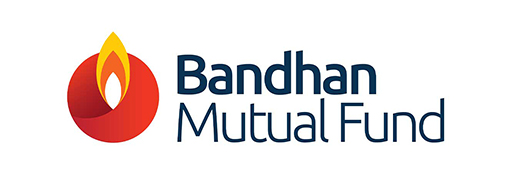Bandhan Healthcare NFO: Invest in structural growth opportunities

Bandhan Mutual Fund announced a new fund offer (NFO), Bandhan Healthcare fund which opened for subscription on 10th November 2025 and will close on 24th November 2025. In this article, we will review the Bandhan Healthcare Fund and examine the opportunities within Healthcare sector that support its investment potential.
Drivers of long-term growth in Indian healthcare sector
- India's median age is set to rise sharply over next two decades, creating long-term demand for healthcare services. Aging population over time is a natural phenomenon in a young country with improving healthcare facilities. The median age is expected to increase by 1.3X (2025-2050). Aging population boosts demand for age-related healthcare services.
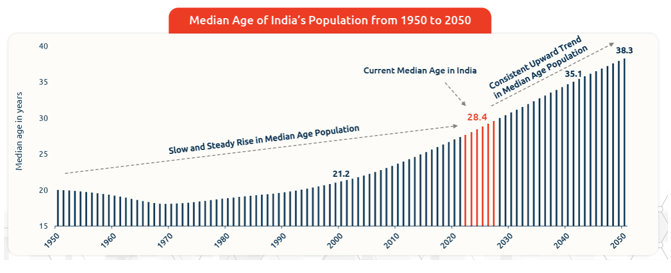
Source: United Nations Department of Economic and Social Affairs (UN DESA)
- Life expectancy is increasing in India. Average life expectancy at birth in 2000 was 63 years, which is expected to increase to 84 years by 2048. Longer life spans fuel healthcare sectors.
- Healthcare spending in India is set to rise. As economies mature, healthcare spend per capita grows. India's healthcare spend is 5.4% of GDP vs. 16.5% in the U.S.

Source: Organization for Economic Co-operation and Development (OECD)- Health Spending, Worldbank. Latest data available as of 2023
- Insurance coverage is expected to rise driven by improved access through Ayushman Bharat Scheme, digital distribution and higher awareness for healthcare insurance. Percentage of lives covered by insurance is expected to increase from 37% in 2022 to an estimated 69% in 2030. As insurance coverage rises, the financial burden of healthcare will reduce allowing access to better healthcare
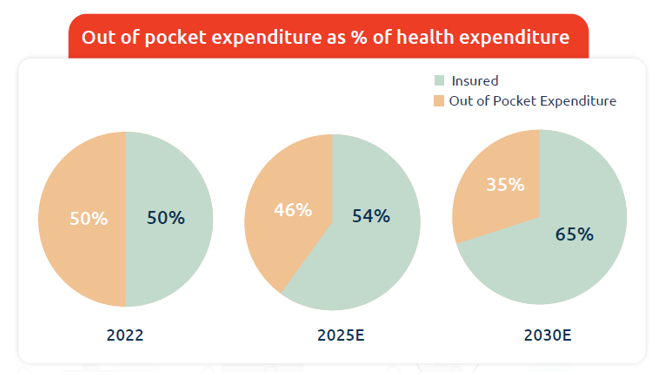
Source: BCG. IRDAI, Niti Aayog. Based on the latest available reports. E: Numbers for 2025 & 2030 are Expected numbers
- India's medical tourism provides quality care at a fraction of global prices. The medical tourism market is poised for significant growth, with its value anticipated to rise from $42 billion in 2024 to $102 billion by 2030, reflecting a strong compound annual growth rate of 16%. The country ranks among the top 10 global destinations for medical tourism, primarily driven by factors such as affordability, adherence to international healthcare standards, widespread use of the English language, and the ease of obtaining visas. In 2024 alone, approximately 4.63 lakh medical visas were issued, underscoring the increasing influx of international patients seeking high-quality and cost-effective medical treatments.
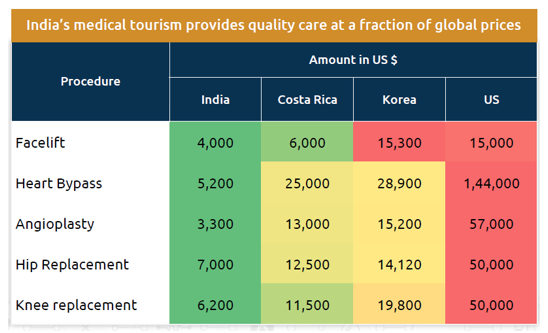
- Healthcare infrastructure is improving in India. Hospital beds expected to increase 12X by 2048. Number of Doctors increased 1.1X in 4 years. Number of medical colleges in India increased by 1.8X to 758 in FY 24 (in 8 years). Healthcare infrastructure is expanding with growing investments in Tier 2-6 cities for multispecialty hospitals, diagnostics, specialty clinics etc.
Long run way for growth
India has a long way to match the healthcare infrastructure standards of developed economies. Under-penetration of health insurance in India results in significantly higher out of pocket expenses compared to developed economies. There is huge growth potential for healthcare and allied sectors in India
- India needs ~3 per 1,000 people whereas the current levels are far below WHO benchmarks. As far as doctors are concerned, there are only 0.7 physicians per 1,000 people vs. 2 in China, 2.6 in the U.S, which further underscores the potential for long term growth in the healthcare sector in India.

Source: WHO, CRISIL research, BCG- A digital pill for revolutionizing healthcare. Data as per WHO estimation 2021
- While India's Healthcare has been moving upwards, it lags compared to other large economies.

Source: Organization for Economic Co-operation and Development (OECD)- Health Spending, World bank. Latest data available as of 2023
- Affordability of Indian generics has allowed Indian pharmaceutical companies to sustain consistent market share in the U.S. Generics account for ~80% of medicines consumed by volume in the U.S., but only 8% by value. Indian players contribute 44% of U.S. generic volumes, but only 23% of the value.
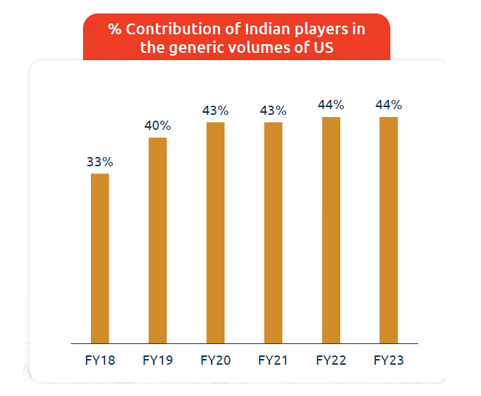
Source: JP Morgan, IQVIA. Generic Medicine - Lower Cost alternative to Brand-Name Drugs
Why should you invest in the Healthcare sector now?
U.S. aging population is driving significant increase in U.S. Healthcare spending: As the median age of US moved from 27 to 37, US Healthcare spendings as % of GDP moved from 9.1% to 20.7%. US GDP had grown at 17x whereas US Healthcare spendings grew at 39x in the same period. This signifies a opportune time for investment into the sector.
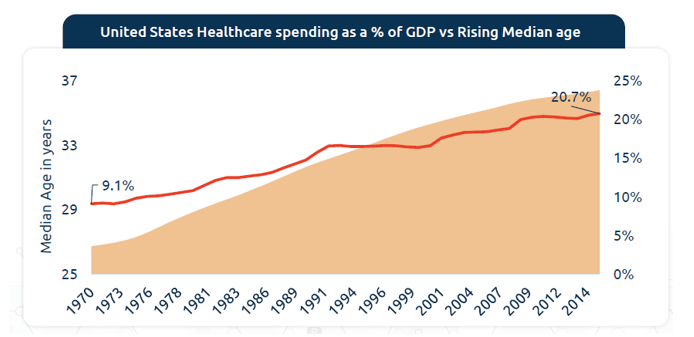
Source: Worldbank Data. US: United States,
Healthcare Index has Outperformed S&P 500 in the last two decades: As healthcare spending rose, it was followed by stock price appreciation in the sector.
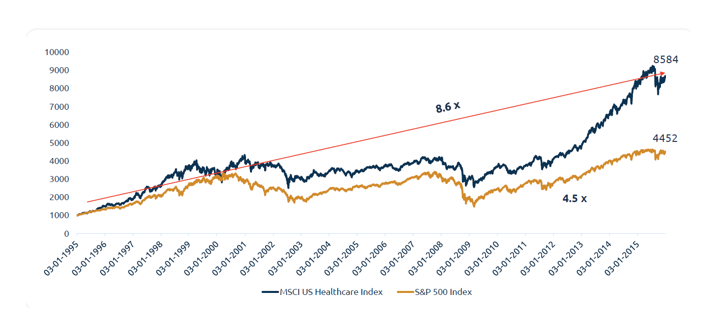
Source: Bloomberg
Diverse opportunities across various sub-segments within Healthcare: Investment in the Healthcare sector gives investors the exposure to the entire gamut of the sub-segments (see graphic) in the healthcare industry; each sub-segment featuring distinct business models with unique economic characteristics. From 2015-2025, the sector has diversified significantly, with firms shifting towards branded offerings and high-growth areas like hospitals and CDMOs. Moving away from commoditized generics into specialty and branded formulations has improved margins and reduced pricing volatility. Consolidation and technology adoption have further strengthened scalability and operational efficiency.

Source: BSE, Index: BSE Healthcare
World Demographic Shift - There is a rising trend in World's median age population. With the global population aging, demand for pharmaceutical products is expected to rise significantly.
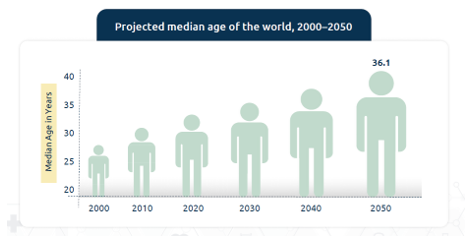
Source: United Nations Department of Economic and Social Affairs (UN DESA)
India's edge in Contract Research and Manufacturing (CRDMO) : Global CRDMO market was valued at $197 bn in 2023 and is expected to grow at 9% CAGR through 2028. India's share in 2023 was 3.6%, offering a long growth runway. India has grown at 12% CAGR over the last 5 years and is projected to grow at 15% CAGR in the next 5 years. India has a cost advantage here as she produces small molecule drugs at ~60% lower cost than the U.S.
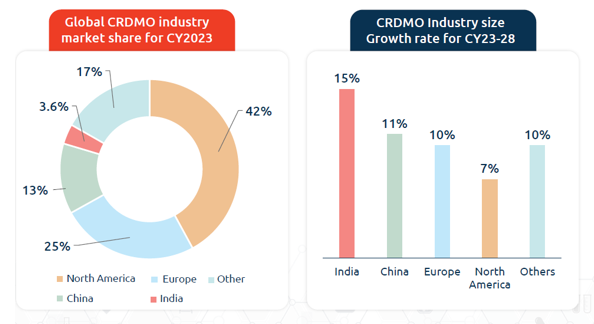
Source: Frost & Sullivan, Jefferies.
Elevated valuations justified by future growth potential: While valuations may appear elevated, they reflect the potential for strong future growth of the sector. Also, the healthcare sector has historically maintained strong balance sheets, steady cash flows and profitability. This financial strength enables them to continue investing in research and development, pursue strategic acquisitions, and deliver steady returns to shareholders. The average PE ratio for Bandhan Healthcare Index Fund was 36.9 for the last 10 years.
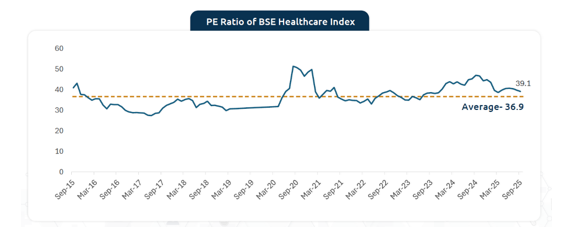
Source: BSE, Index: BSE Healthcare.
Strong fundamentals: balance sheets, profitability: Low debt, steady cash flows, consistent profitability. Demonstrates quality and resilience in volatile environments.

Source: Bloomberg , Index: BSE Healthcare Index and Nifty 500 Index
Potential of getting superior returns over long investment tenures: The chart below shows the 3-year rolling returns of Nifty Healthcare TRI versus the Nifty 500 Index since the inception of the healthcare index. You can see that healthcare index consistently outperformed the broad market except a 3 - 4 year period when several Indian pharma companies were subject to US FDA inspections. Over the last 20 years, the average and median 3 year rolling returns of the healthcare index (17.2% and 15.3% respectively) were higher than the average and median rolling returns of Nifty 500 TRI (17% and 13%) respectively.

Source: Advisorkhoj Research, Period: 1st April 2005 to 22nd August 2025
Underweight in indices leading to possible headroom for potential growth
The sector is underrepresented in Indian Markets reflecting upside potential.

Source: Bloomberg, Index: Nifty 500 Index. Above data is of financial year. Current Data as on 30th September 2025, E: Expected Numbers
Indian pharma: 11% CAGR (last 4 years), projected to maintain momentum through 2030.
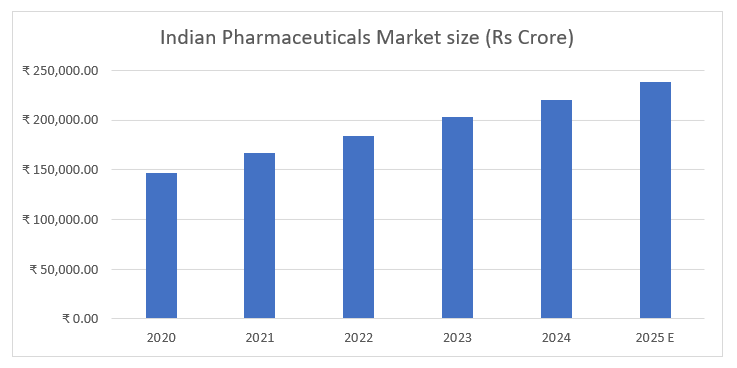
Source: Pharmarack, IQVIA. E: Expected Numbers
Bandhan Healthcare Fund NFO
The scheme is managed by Fund managers Mr. Viraj Kulkarni for Equity portion, and Mr. Brijesh Shah for Debt portion, seeks to generate long-term capital appreciation by investing predominantly in equity and equity-related instruments of companies engaged in Healthcare, Pharma and Allied sectors. Ms. Ritika Behera & Mr. Gaurav Satra manage overseas investment portion of the scheme. The benchmark of the scheme is BSE Healthcare TRI.
Portfolio Construct
- The fund managers employ a top-down approach for core allocation across 4 key themes (20-30% each). Tactical shifts based on Management quality, Growth outlook, ROCE and valuations.
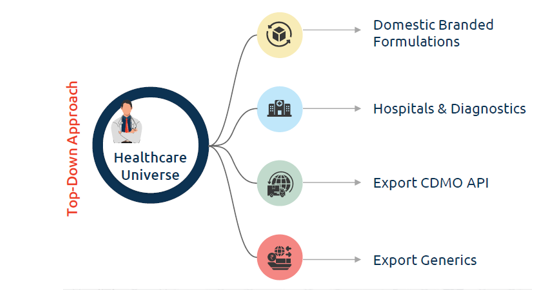
- A segment specific analysis (bottom-up approach) is conducted for stock selection as follows:
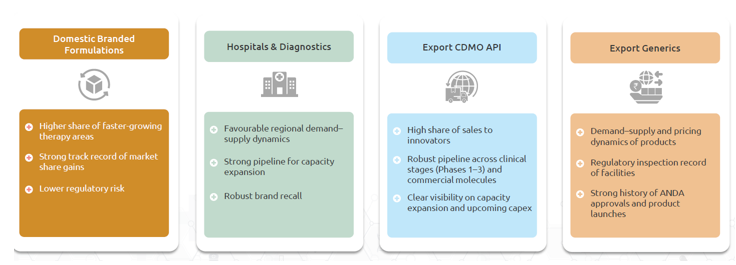
ANDA: Abbreviated New Drug Application, CDMO: Contract Development and Manufacturing Organization. API: Active Pharmaceutical Ingredient
Who Should invest in the Bandhan Healthcare NFO?
- Investors seeking exposure to a high-potential growth sector fuelled by structural megatrends (aging, chronic diseases, rising access).
- Those looking to diversify with thematic strategies offering both growth and defensive characteristics
- Investors comfortable with higher volatility in pursuit of potentially higher returns compared to broad-market funds.
India's population is approaching a demographic inflection point, with the median age projected to increase significantly over the next decade. Growing median age will drive higher demand for healthcare services, particularly in elderly care and the management of lifestyle-related diseases.
Thus, investing in the healthcare category presents a compelling opportunity due to its strong demand and long-term growth potential.
Consult a mutual fund distributor or your Financial Advisor to understand if the Bandhan Healthcare fund aligns to your investment needs
Mutual Fund Investments are subject to market risk, read all scheme related documents carefully.
Bandhan AMC Limited (formerly IDFC Asset Management Company Limited), established in 2000, is one of India's Top 10 fund houses in terms of Asset Under Management. It has an experienced investment team with an on-the-ground presence in over 60 cities. Bandhan Mutual Fund is focused on helping savers become investors and create wealth. To support this objective, the fund house's equity and fixed-income offerings aim to provide performance consistent with their well-defined objectives. It is having its Registered Office at - Bandhan AMC Limited, One World Center, 6th floor, Jupiter Mills Compound,841, Senapati Bapat Marg, Elphinstone Road, Mumbai: 400 013
Investor Centre
Follow Bandan MF
More About Bandan MF
POST A QUERY



